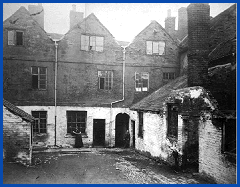
The Elan Valley dams
Birmingham's need for water,1890
In the closing years of the nineteenth century the city of Birmingham, in the English midlands, was under pressure from the growing pace of industrialisation. Its population was expanding rapidly as workers and their families were attracted by the prospect of new jobs in the factories and mills, even though living conditions for many in the slum districts of the city were appalling. Similar problems existed in many other industrial cities in Britain.
Birmingham slums.
Thomas Street,
demolished 1876
Birmingham
Central Library
 Large numbers
of people had to use wells polluted by sewage. The crowded and
unsanitory conditions often resulted in deadly epidemics of water-borne
diseases such as typhoid and cholera.
Large numbers
of people had to use wells polluted by sewage. The crowded and
unsanitory conditions often resulted in deadly epidemics of water-borne
diseases such as typhoid and cholera.
The essential need in order to combat these was an ample supply of clean water, for the amount of water used in the city had doubled between 1876 and 1891. There was little prospect of being able to meet the ever growing demand for water from existing sources.
This extract on this
page is from
"The Future Water
Supply of Birmingham"
by Thomas Barclay,
published in 1898.
Treasures of untold value
The Corporation of Birmingham was understandably anxious to secure
new water supplies for the city sufficient to meet its needs
for many years ahead. The Water Committee had commissioned surveys
in 1891 of possible sources of new water, and the area around
the valleys of the rivers Elan and Claerwen in mid-Wales, some
75 miles to the west, were reported by experts to be ideal for
the purpose.
Thomas Barclay, a member of the Committee, wrote proudly of
the foresight of the city fathers of Birmingham :
"True to its motto, our Corporation has taken time by the
forelock, and seeing that something like ten years will be required
to bring the work to completion, has commenced its preparations
already....it has decided to aquire these treasures of untold
value".
The choice of the Elan Valley as the source of Birmingham's future
water supplies was to lead to the creation of a spectacular new
landscape in mid-Wales.